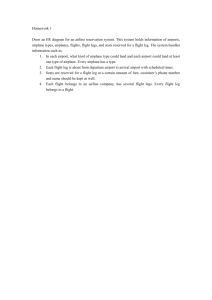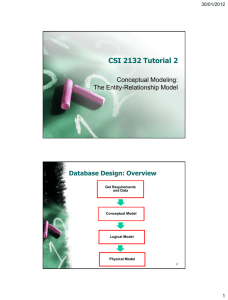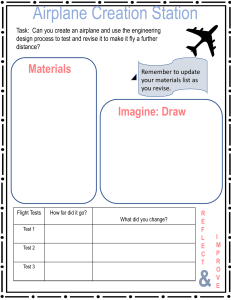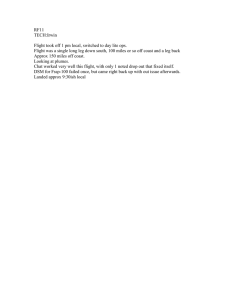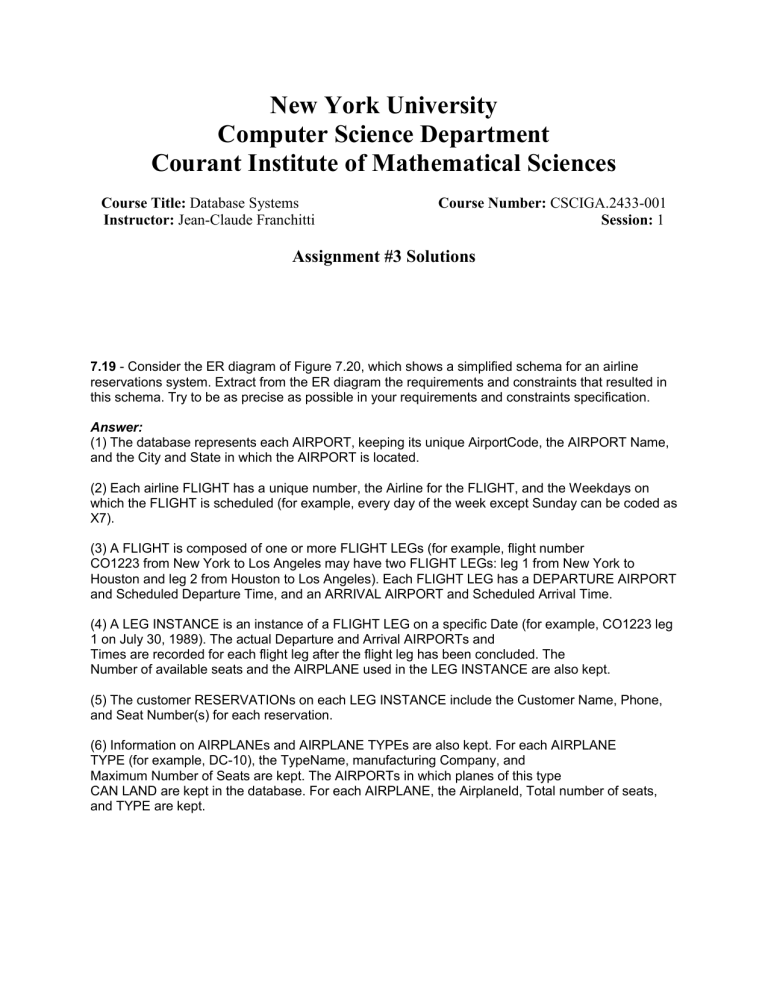
New York University
Computer Science Department
Courant Institute of Mathematical Sciences
Course Title: Database Systems
Instructor: Jean-Claude Franchitti
Course Number: CSCIGA.2433-001
Session: 1
Assignment #3 Solutions
7.19 - Consider the ER diagram of Figure 7.20, which shows a simplified schema for an airline
reservations system. Extract from the ER diagram the requirements and constraints that resulted in
this schema. Try to be as precise as possible in your requirements and constraints specification.
Answer:
(1) The database represents each AIRPORT, keeping its unique AirportCode, the AIRPORT Name,
and the City and State in which the AIRPORT is located.
(2) Each airline FLIGHT has a unique number, the Airline for the FLIGHT, and the Weekdays on
which the FLIGHT is scheduled (for example, every day of the week except Sunday can be coded as
X7).
(3) A FLIGHT is composed of one or more FLIGHT LEGs (for example, flight number
CO1223 from New York to Los Angeles may have two FLIGHT LEGs: leg 1 from New York to
Houston and leg 2 from Houston to Los Angeles). Each FLIGHT LEG has a DEPARTURE AIRPORT
and Scheduled Departure Time, and an ARRIVAL AIRPORT and Scheduled Arrival Time.
(4) A LEG INSTANCE is an instance of a FLIGHT LEG on a specific Date (for example, CO1223 leg
1 on July 30, 1989). The actual Departure and Arrival AIRPORTs and
Times are recorded for each flight leg after the flight leg has been concluded. The
Number of available seats and the AIRPLANE used in the LEG INSTANCE are also kept.
(5) The customer RESERVATIONs on each LEG INSTANCE include the Customer Name, Phone,
and Seat Number(s) for each reservation.
(6) Information on AIRPLANEs and AIRPLANE TYPEs are also kept. For each AIRPLANE
TYPE (for example, DC-10), the TypeName, manufacturing Company, and
Maximum Number of Seats are kept. The AIRPORTs in which planes of this type
CAN LAND are kept in the database. For each AIRPLANE, the AirplaneId, Total number of seats,
and TYPE are kept.
8.19 - Identify all the important concepts represented in the library database case study described
here. In particular, identify the abstraction of classification (entity types and relationship types),
aggregation, identification, and specialization/generalization. Specify (min, max) cardinality
constraints whenever possible. List details that will affect the eventual design but which have no
bearing on the conceptual design. List the semantic separately. Draw an EER diagram of the library
database.
Answer:
8.21 - Figure 8.12 shows an example of an EER diagram for a small private airport database that is
used to keep track of airplanes, their owners, airport employees, and pilots. From the requirements
for this database, the following information was collected: Each airplane has a registration number
[Reg#], is of a particular plane type [of_type], and is stored in a particular hangar [stored_in]. Each
plane_type has a model number [Model], a capacity [Capacity], and a weight [Weight]. Each hangar
has a number [Number], a capacity [Capacity], and a location [Location]. The database also keeps
track of the owners of each plane [owns] and the employees who have maintained the plane
[maintain]. Each relationship instance in owns relates an airplane to an owner and includes the
purchase date [Pdate]. Each relationship instance in maintain relates to an employee to a service
record [service]. Each plane undergoes service many times; hence, it is related by [plane_service] o
a number of service records. A service record includes as attributes the date of maintenance [Date],
the number of hours spent on the work [Hours], and the type of work done [Workcode]. We use a
weak entity type [service] to represent airplane service, because the airplane registration number is
used to identify a service record. An owner is either a person or a corporation. Hence, we use a
union type (category) [owner] that is a subset of the union of corporation [Corporation] and person
[Person] entity types. Both pilots {Pilot] and employees [Employee] are subclasses of person. Each
pilot has specific attributes license number [Lic_Num] and restrictions [Restr]; each employee has
specific attributes salary [Salary] and shift {Shift]. All person entities in the database have data kept
on their social security number [Ssn], name [Name], address [Address], and telephone number
[Phone]. For corporation entities, the data kept includes name [Name], address [Address], and
telephone number [Phone]. The database also keeps track of the types of planes each pilot is
authorized to fly [Flies] and the types of planes each employee can do maintenance work on
[Works_on]. Show how the small airport EER schema of Figure 8.12 may be represented in UML
notation. (Note: We have not discussed how to represent categories (union types) in UML, so you do
not have to map the categories in this and the following question.)
Answer:
8.27 - Consider the following EER diagram that describes computer systems at a company. Provide
your own attributes and key for each entity type. Supply max cardinality constraints justifying your
choice. Write a complete narrative description of what this EER diagram represents.
Answer:
Installed
Software
Computer
InstalledOS
d
U
Laptop
SoldWith
U
U
Desktop
Operating
System
Supports
Options
Options
Component
Accessory
d
U
Keyboard
d
U
U
Monitor
U
Mouse
Memory
U
U
Sound card
Video card
